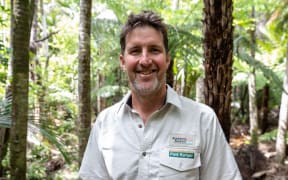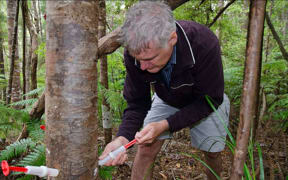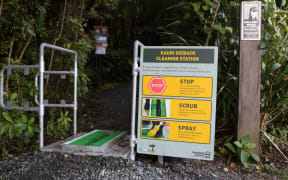Kauri dieback disease means some of the most popular tracks and campgrounds around New Zealand will be closed this summer.
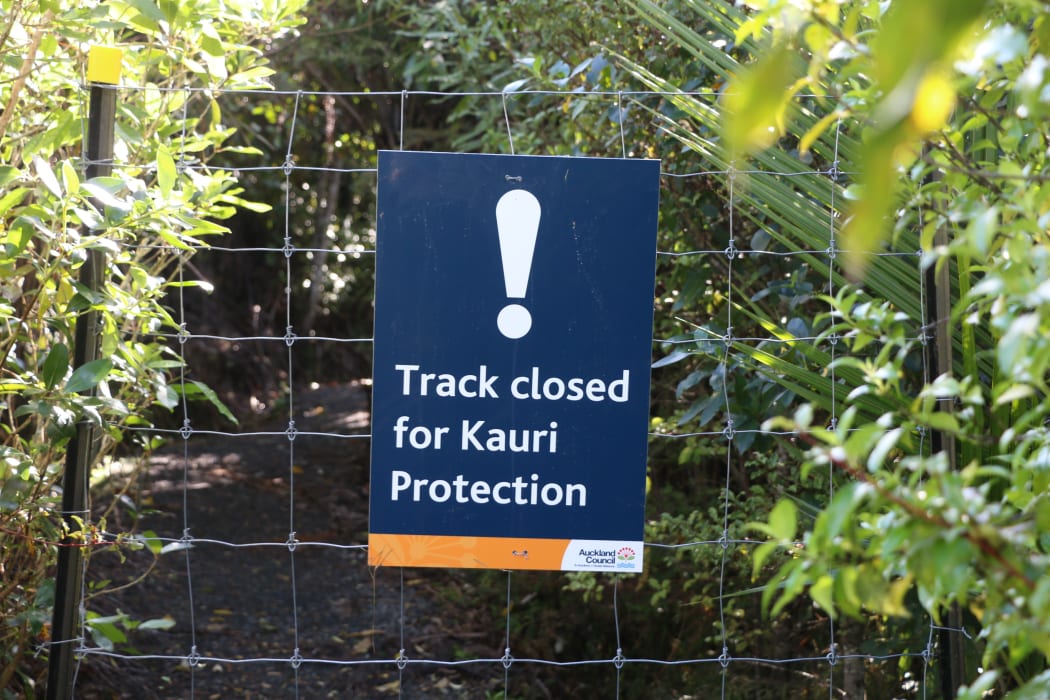
Kauri dieback disease has led to the closure of more than 100 tracks in Auckland and many other tracks around the North Island. Photo: RNZ / Eva Corlett
Auckland Council has closed more than 100 tracks in the Waitākere Ranges and in other parks, while nine campgrounds in the Auckland region are shut due to concerns about dying kauri trees.
The Department of Conservation (DOC) has closed 21 tracks around the North Island.
Both DOC and Auckland Council offer plenty of ideas for alternative tracks that remain open - see the list below.
Keeping people off infected tracks is vital to stop the spread of the disease that has killed thousands of kauri trees, Biosecurity New Zealand's manager for recovery and pest management John Sanson said.
Over recent decades, kauri dieback has infected trees in every region of the country where kauri grow.
But there were still many forest areas where the disease had not been detected, such as the Hunua ranges, most of the Coromandel and Waiheke Island - "and we want to keep it that way," Mr Sanson said.
"Human activity is the most common cause of the disease spreading - through transfer of contaminated soil on footwear and equipment," he said.
"We can only stop it spreading by everyone doing the right thing.
"This means cleaning footwear and equipment, sticking to the track and keeping off kauri roots, which are particularly vulnerable to infection."
There is currently no known cure for kauri dieback, a disease that fells trees that can otherwise live to be 2000 years old, grow up to 50m tall and have girths of 16m.
The pathogen that causes the disease was first recorded on Great Barrier Island in the early 1970s, but was misdiagnosed.
In 2006, dying kauri were seen in the Waitākere Ranges and an investigation began.
A newly discovered species of pathogen, Phytophthora agathidicidia, was formally recognised in 2008 and the national Kauri Dieback Programme was launched in 2009.
But kauri dieback is believed to have been killing the forest giants since the 1950s.
"One of the particular challenges of identifying and dealing with the disease is that its symptoms can remain hidden for decades before a tree shows any sign," Mr Sanson said.
Recent trials of phosphite injections, which boost the natural immunity of kauri trees, are showing promise.
Research is underway to find trees with genetic resistance to dieback. These trees would be propagated and planted out in diseased areas.
Funding for the Kauri Dieback Programme is just under $1.9 million for the 2017 to 2018 year, with an extra $750,000 to create a new agency and management plan.
The government recently announced a funding increase of $8.75m over three years for dieback research. This is on top of $4.7m allocated for research in 2018/19.
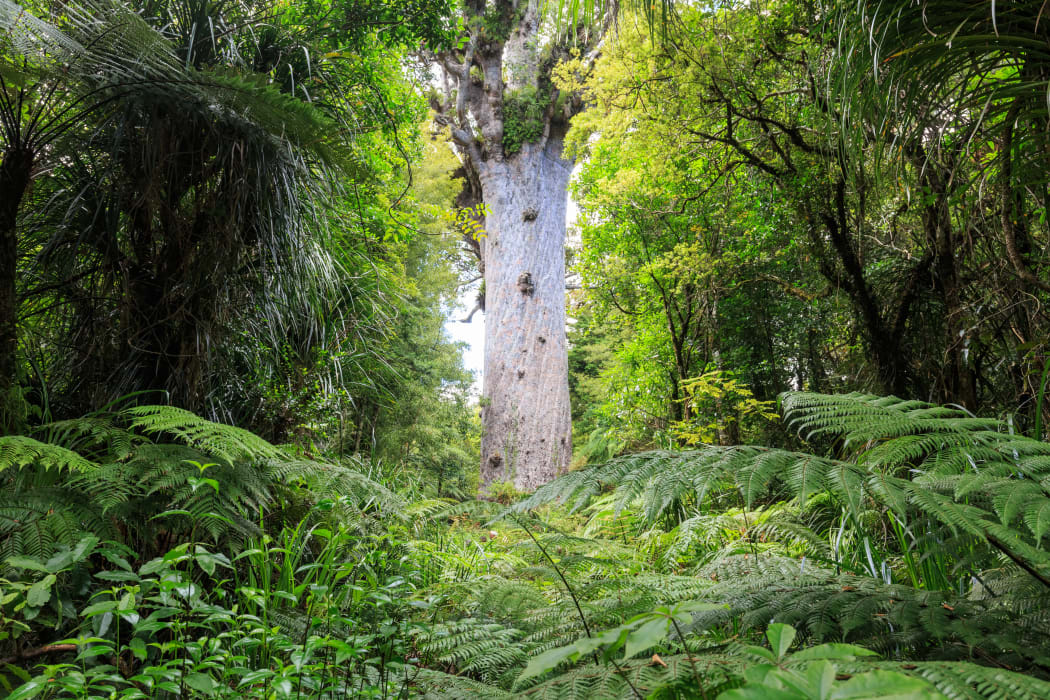
The track to see Tāne Mahuta remains open. Photo: 123rf
While dieback has probably killed thousands of trees, the majority of kauri do not appear to be infected.
However, if the disease continued spreading, the impacts could be "devastating", Mr Sanson said.
"Kauri are a keystone species, meaning they shape the ecosystem that they live in, with many other species relying on them," he said.
"If kauri die, then the kauri forest ecosystem dramatically changes to the detriment of other species. If people want kauri to be alive for future generations, then they all need to play their part."
A year ago, Te Kawerau ā Maki placed a rāhui over Te Waonui a Tiriwa - the forested area of the Waitākere Ranges. The cultural prohibition, requiring people to keep away from the area, remains in place.
Auckland Council has closed 110 tracks in the Waitākere ranges, seven of which are permanently closed.
Five Waitākere campgrounds are closed - Karamatura Valley, Odlins 2, Opanuku Pipeline, Pararaha Valley, and Whatipu Caves Campground.
Four Hunua campgrounds are closed - Adam's Lookout, Mangatangi Trig, Thousand Acres, and Workman Campground.
Kauri dieback concerns have led to the closure of 10 high risk tracks in Hunua Ranges Regional Park, two tracks on Waiheke Island and one track in Clevedon Scenic Park.
Four reserves on Auckland's North Shore are closed - Kauri Park, Muriel Fisher Reserve, Chatswood Reserve and Chelsea Estate Heritage Park.
Six great walks in the Waitākere and Hunua parks are still open, but have Controlled Area Notices requiring people to clean and spray footwear and stay on the open tracks.
The open tracks include:
- The Mercer Bay Loop Walk: a one-hour return walk from Log Race Rd in Piha to Te Āhua Point that follows the highest sea cliffs in the Auckland region and offers sweeping views of the West Coast.
- The two-hour return walk, Pae O Te Rangi Farm Summit, starts from the stockyards on Bethells Rd and crosses farmland to a high point with views over Kaipara Harbour and Muriwai Beach.
- Tunnel Point is a 1.5 hour return walk from the Pōhutukawa glade walk at Karekare Beach. Walkers continue south along Whatipu Beach and follow Hillary Trail markers through sand dunes and wetlands to Tunnel campsite, named after a tunnel made through the headland when a tramline ran there. A vehicle track leads back to the beach for the return journey to Karekare.
- Wairoa Loop Track is a three-hour return walk from the south side of Wairoa picnic site to a lookout, with views of Wairoa Reservoir.
- Cossey Gorge/Massey Track Loop is a three-hour return track.
- The Hunua Falls Loop Walk is a short track to a spectacular waterfall, taking 20 minutes return.
DOC has closed Kauri Bush Track in Kaitaia and four tracks on the Kauri Coast - Hukatere, Lookout Track, Toatoa and Tutamoe tracks. However, the massive Tāne Mahuta kauri tree can still be seen, and the short Four Sisters Walk and Trounson Kauri Park Loop are open.
Five tracks have been shut in Whangārei - Bratty's Bush, Cullen Rd to Massey Rd, Massey Rd to State Highway 1, Pukemoremore to the southern section of Russell track, and the northern section of Russell track to Te Ranga Trig.
The Tāne Moana walkway and Te Araroa Trail are among the alternative DOC tracks open in Whangarei.
In Tauranga, five tracks have been closed, including the Bluff Stream Kauri Track and the track to Waitengaue Hut Track, Cashmores Clearing, Mangakino Stream, and Wairoa Stream Track.
The 4.3km Karangahake Mountain track is open and takes about four hours return, leading over the forested flanks of the mountain to its summit.
In Hauraki, Devcich Kauri Track, Hihi Stream to Motutapere, and Waipaheke Motorbike Track are closed.
DOC points walkers to the Old Wires Track and Piraunui Track among a range of alternatives.
In Waikato, Kauri Route at Te Kauri park is closed, and on Great Barrier Island, the Whangaparapara Peak Track to Link Track is shut, but many other walks remain open.
